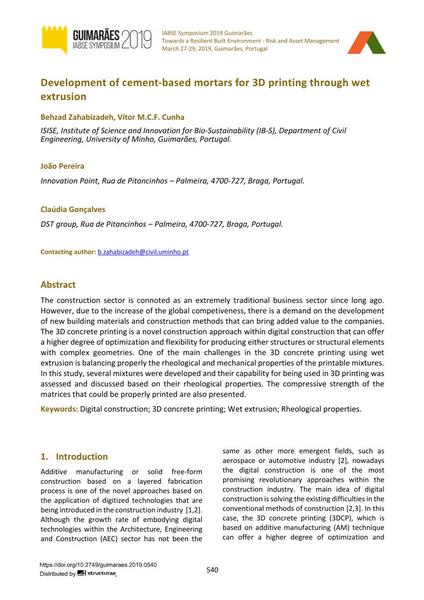Development of cement-based mortars for 3D printing through wet extrusion

|
|
|||||||||||
Bibliographic Details
| Author(s): |
Behzad Zahabizadeh
(ISISE, Institute of Science and Innovation for Bio-Sustainability (IB-S), Department of Civil Engineering, University of Minho, Guimarães, Portugal.)
Vítor M. C. F. Cunha (ISISE, Institute of Science and Innovation for Bio-Sustainability (IB-S), Department of Civil Engineering, University of Minho, Guimarães, Portugal.) João Pereira (Innovation Point, Rua de Pitancinhos – Palmeira, 4700-727, Braga, Portugal.) Cláudia Gonçalves (DST group, Rua de Pitancinhos – Palmeira, 4700-727, Braga, Portugal.) |
||||
|---|---|---|---|---|---|
| Medium: | conference paper | ||||
| Language(s): | English | ||||
| Conference: | IABSE Symposium: Towards a Resilient Built Environment Risk and Asset Management, Guimarães, Portugal, 27-29 March 2019 | ||||
| Published in: | IABSE Symposium Guimarães 2019 | ||||
|
|||||
| Page(s): | 540-547 | ||||
| Total no. of pages: | 8 | ||||
| DOI: | 10.2749/guimaraes.2019.0540 | ||||
| Abstract: |
The construction sector is connoted as an extremely traditional business sector since long ago. However, due to the increase of the global competiveness, there is a demand on the development of new building materials and construction methods that can bring added value to the companies. The 3D concrete printing is a novel construction approach within digital construction that can offer a higher degree of optimization and flexibility for producing either structures or structural elements with complex geometries. One of the main challenges in the 3D concrete printing using wet extrusion is balancing properly the rheological and mechanical properties of the printable mixtures. In this study, several mixtures were developed and their capability for being used in 3D printing was assessed and discussed based on their rheological properties. The compressive strength of the matrices that could be properly printed are also presented. |
||||
| Keywords: |
digital construction 3D concrete printing Wet extrusion Rheological properties
|
||||

